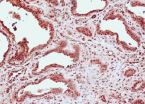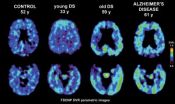(Press-News.org) The Aurora A kinase may contribute to polycystic kidney disease (PKD) by inactivating a key calcium channel in kidney cells, according to a study in the June 13 issue of The Journal of Cell Biology (www.jcb.org).
Aurora A is an oncogene best known as a regulator of mitotic progression. But the kinase has important functions during interphase as well, when it can promote cilia disassembly and can be activated by elevated calcium levels. Because both calcium signaling and cilia are defective in PKD, researchers from the Fox Chase Cancer Center in Philadelphia wondered whether Aurora A might contribute to the pathology of this common genetic disease.
The researchers found that Aurora A was up-regulated and activated in epithelial cells lining the cysts in PKD patient kidneys. In addition, Aurora A bound to and phosphorylated a calcium channel called polycystin-2, whose gene, PKD2, is often mutated in autosomal dominant forms of PKD.
Polycystin-2 mediates the release of calcium from storage in the endoplasmic reticulum and calcium influx into cilia. Inhibition or knockdown of Aurora A boosted intracellular calcium levels, but this effect was less pronounced in kidney cells lacking polycystin-2, indicating that Aurora A normally lowers calcium levels by inactivating polycystin-2. Only small doses of inhibitor were required to increase calcium levels, suggesting that Aurora A may be a viable therapeutic target for boosting polycystin-2 activity in certain PKD patients. Senior author Erica Golemis now wants to investigate how Aurora A becomes up-regulated in PKD and whether inhibitors of the kinase can slow cyst formation in mouse models of the disease.
INFORMATION:
About The Journal of Cell Biology
Founded in 1955, The Journal of Cell Biology (JCB) is published by The Rockefeller University Press. All editorial decisions on manuscripts submitted are made by active scientists in conjunction with our in-house scientific editors. JCB content is posted to PubMed Central, where it is available to the public for free six months after publication. Authors retain copyright of their published works and third parties may reuse the content for non-commercial purposes under a creative commons license. For more information, please visit www.jcb.org.
Plotnikova, O.V., and E.A. Golemis. 2011. J. Cell Biol. doi:10.1083/jcb.201012061.
Aurora A may contribute to kidney disease
2011-06-14
ELSE PRESS RELEASES FROM THIS DATE:
High rates of injection drug use in urban Aboriginal youth signal need for prevention programs
2011-06-14
A new study indicates high rates of injection drug use in urban Canadian Aboriginal youth, particularly in women, and points to the need for culturally specific prevention programs, states an article in CMAJ (Canadian Medical Association Journal) (pre-embargo link only) http://www.cmaj.ca/embargo/cmaj101257.pdf
Aboriginal leadership is alarmed at the levels of substance abuse in their young people, especially injection drug use, which is associated with HIV and hepatitis C virus infections. Injection drug use accounts for 70%% of all hepatitis C virus and almost ...
Health data can help address alcohol-related harm in youth
2011-06-14
Administrative information can be useful for surveillance and understanding of alcohol-related harm in young people, states an article in CMAJ (Canadian Medical Association Journal) (pre-embargo link only) http://www.cmaj.ca/embargo/cmaj110367.pdf
Binge drinking and overconsumption of alcohol by young people is a growing issue in many countries. For example, in a 2009 study, almost 60% of young Canadians aged 15-24 reported having consumed alcohol in the previous month, with 22% reporting heaving drinking and 20% experiencing harm related to alcohol consumption. In Australia, ...
Safe prescribing information for children in Canada often hard to find
2011-06-14
Accurate, safe prescribing information for children is often unavailable to doctors in Canada because pharmaceutical companies will not disclose information to Health Canada, states an editorial in CMAJ (Canadian Medical Association Journal) (pre-embargo link only) http://www.cmaj.ca/embargo/cmaj110563.pdf
Health professionals in Canada as well as other countries such as Japan and Australia, unlike their colleagues in the United States and Europe, do not have access to the same body of evidence regarding pediatric dosing.
"As a consequence, Canadian children and youth ...
Glowing Cornell dots -- a potential cancer diagnostic tool set for human trials
2011-06-14
NEW YORK – The U.S. Food and Drug Administration (FDA) has approved the first clinical trial in humans of a new technology: Cornell Dots, brightly glowing nanoparticles that can light up cancer cells in PET-optical imaging.
A paper describing this new medical technology, "Multimodal silica nanoparticles are effective cancer-targeted probes in a model of human melanoma," will be published June 13, 2011 in the Journal of Clinical Investigation (July 2011). This is a collaboration between Memorial Sloan-Kettering Cancer Center (MSKCC), Cornell University, and Hybrid Silica ...
More genetic diseases linked to potentially fixable gene-splicing problems
2011-06-14
PROVIDENCE, R.I. [Brown University] — A new Brown University computer analysis that predicts the effect of genetic mutations on how the body splices mRNA indicates as many as a third of disease-related mutations may be linked to splicing problems — more than double the proportion previously thought.
"Something like 85 percent of the mutations in the Human Gene Mutation Database are presumed to affect how proteins are coded, but what this work shows is that 22 percent of those are affecting the splicing process," said William Fairbrother, assistant professor of biology ...
Decoding chronic lymphocytic leukemia
2011-06-14
A paper published online on June 13 in the Journal of Experimental Medicine (www.jem.org) identifies new gene mutations in patients with chronic lymphocytic leukemia (CLL)—a disease often associated with lack of response to chemotherapy and poor overall survival.
CLL is the most common leukemia in the Western world, but the disease varies greatly from patient to patient with regard to prognosis, survival, and disease course. In attempt to understand the genetic basis for this heterogeneity, a group led by Riccardo Dalla-Favera at Columbia University and Gianluca Gaidano ...
NIH researchers find new clues about aging
2011-06-14
National Institutes of Health researchers have identified a new pathway that sets the clock for programmed aging in normal cells. The study provides insights about the interaction between a toxic protein called progerin and telomeres, which cap the ends of chromosomes like aglets, the plastic tips that bind the ends of shoelaces.
The study by researchers from the National Human Genome Research Institute (NHGRI) appears in the June 13, 2011 early online edition of the Journal of Clinical Investigation.
Telomeres wear away during cell division. When they degrade sufficiently, ...
Sniffing out a new source of stem cells
2011-06-14
A team of researchers, led by Emmanuel Nivet, now at the Salk Institute for Biological Studies, La Jolla, has generated data in mice that suggest that adult stem cells from immune system tissue in the smell-sensing region of the human nose (human olfactory ecto–mesenchymal stem cells [OE-MSCs]) could provide a source of cells to treat brain disorders in which nerve cells are lost or irreparably damaged.
Stem cells are considered by many to be promising candidate sources of cells for the regeneration and repair of tissues damaged by various brain disorders (including traumatic ...
JCI online early table of contents: June 13, 2011
2011-06-14
EDITOR'S PICK: Sniffing out a new source of stem cells
A team of researchers, led by Emmanuel Nivet, now at the Salk Institute for Biological Studies, La Jolla, has generated data in mice that suggest that adult stem cells from immune system tissue in the smell-sensing region of the human nose (human olfactory ecto–mesenchymal stem cells [OE-MSCs]) could provide a source of cells to treat brain disorders in which nerve cells are lost or irreparably damaged.
Stem cells are considered by many to be promising candidate sources of cells for the regeneration and repair ...
Brain scan identifies patterns of plaques and tangles in adults with Down syndrome
2011-06-14
In one of the first studies of its kind, UCLA researchers used a unique brain scan to assess the levels of amyloid plaques and neurofibrillary tangles — the hallmarks of Alzheimer's disease — in adults with Down syndrome.
Published in the June edition of the Archives of Neurology, the finding may offer an additional clinical tool to help diagnose dementia in adults with Down syndrome, a genetic disorder caused by the presence of a complete or partial extra copy of chromosome 21.
Adults with this disorder develop Alzheimer's-like plaque and tangle deposits early, ...

